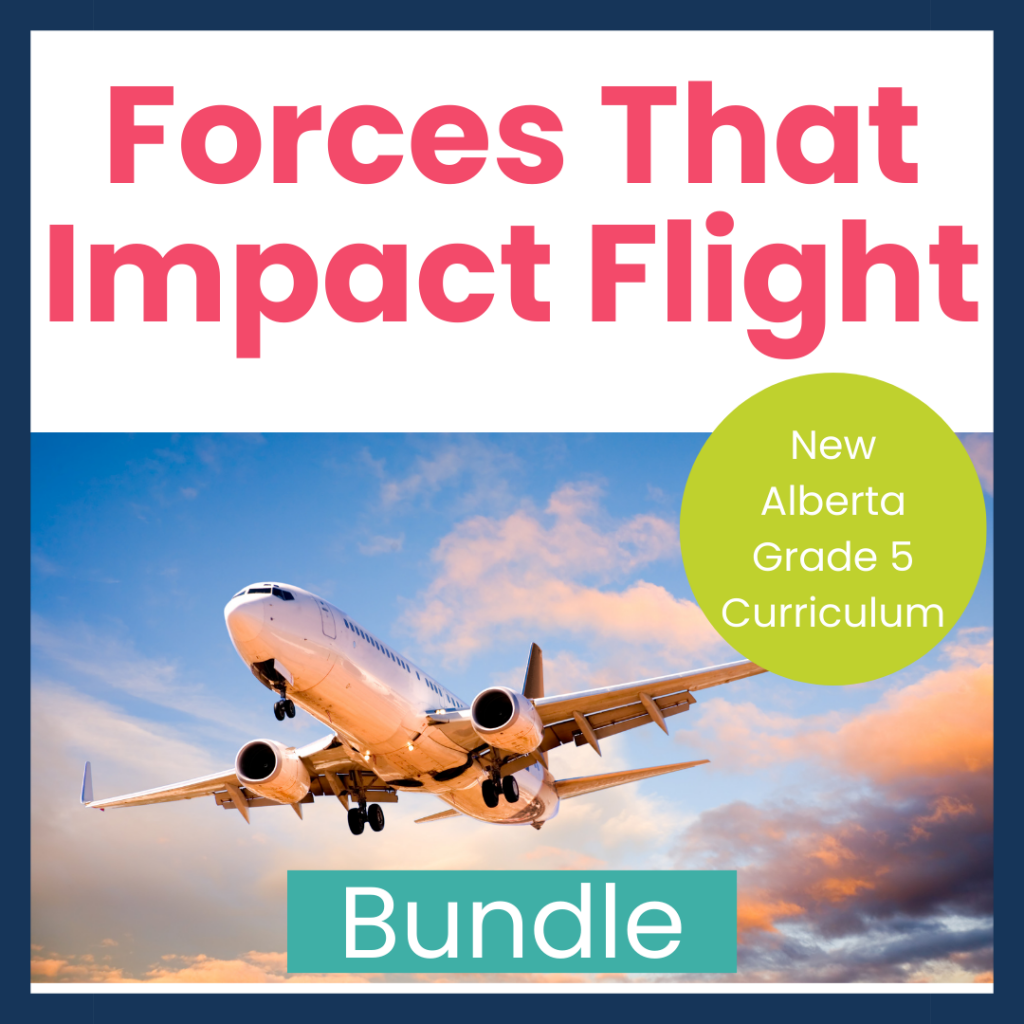Teaching the Forces of Flight: A Fun Approach for Alberta Grade 5 Teachers
As we dive into the new Alberta Grade 5 Science curriculum, one of the most thrilling topics on our radar is the forces of flight. Whether your students dream of becoming astronauts, pilots, or simply love the idea of defying gravity, teaching about how planes and birds soar can be a thrilling and hands-on experience for them—and for you too! Which, let’s be real, is kind of a miracle because this new curriculum is tricky!
So, let’s get ready to turn the complex concepts of flight forces into a fun, engaging, and even a bit magical learning experience for your class. Here’s how you can do it:
1. Introduce the Four Forces of Flight:
To begin, make sure your students are familiar with the four main forces of flight—Lift, Weight, Thrust, and Drag. You can keep this simple by introducing each force with a hands-on activity or an interactive discussion.
- Lift: The upward force that opposes gravity. Think of it as the force that helps airplanes and birds rise into the sky.
- Weight: The force that pulls everything towards the Earth. Gravity’s work here!
- Thrust: The forward force created by engines or muscles (for birds).
- Drag: The resistance force that slows things down as they move through the air.
2. Use Fun Visual Aids & Experiments:
Start with real-world examples to bring these forces to life. Bring in pictures of planes, birds, and kites to show how different vehicles and creatures use these forces to stay in the air.
And, of course, nothing beats hands-on learning! You can have your students design their own paper airplanes, experiment with different designs, and track how the force of lift changes with modifications in the plane’s wings. This Alberta Grade 5 Science experiment will also give them a tangible understanding of drag and thrust as they observe how planes glide and speed through the air.
3. Make it Relevant with Everyday Life Examples:
Students love when they can connect what they’re learning to their lives outside the classroom. You can use examples like how birds use their wings to navigate through the sky or how helicopters generate thrust. How about visiting your local airport or showing clips of exciting airplane take-offs and landings? Your Alberta Grade 5 science students will love it! (A virtual field trip is always a great option too!)
You can also ask them to think about sports—ever seen a frisbee flying through the air? It’s a perfect example of how thrust, drag, and lift come together to create the flight path.
4. Take Flight with Engaging Resources:
Want to take your lessons to the next level? I’ve got a super resource for you! My Forces of Flight Science Unit on TeachersPayTeachers offers a complete unit tailored to the new Alberta Grade 5 Science curriculum. With engaging activities, lesson plans, and student worksheets, this resource will save you time and help keep your students engaged while diving into the forces that help things soar.

The best part? It’s Alberta-specific, so you don’t have to worry about adapting materials—you’ll be all set to teach the forces of flight in no time. 🎉
The unit includes interactive activities that break down complex concepts like lift and drag into manageable, bite-sized lessons. There are also plenty of creative experiments and worksheets that will keep your students engaged and eager to learn more!
5. Evaluate with Fun and Creativity:
As the unit wraps up, why not assess your students’ understanding of this Alberta Grade 5 Science topic through a creative project? Have them create their own flying vehicle or design a new type of bird using the principles of flight they’ve learned. Not only does this allow them to apply their knowledge, but it also gives them an opportunity to show off their creativity.
If you’re looking for a simple, fun way to wrap up the unit, you could even host a classroom “flight” competition, where students test out their designs and see which ones can stay airborne the longest!
Final Thoughts:
Teaching the forces of flight can be a fun, interactive experience for both you and your students. By connecting abstract scientific concepts to hands-on experiments and everyday examples, you’ll keep your students excited about science and help them understand how forces impact the world around us.
And remember, if you’re looking for a comprehensive, Alberta-specific resource to help teach these concepts, check out the Alberta Grade 5 Science Forces of Flight Unit on TeachersPayTeachers! It’s a great way to save time, stay organized, and ensure your students have a fantastic learning experience.
Happy teaching, and may the forces be with you! ✈️🌟
PS: Interested in making your flight unit a breeze? Check out the Forces of Flight Science Unit on TeachersPayTeachers—it’s packed with fun activities and easy-to-follow lessons that align with the Alberta curriculum!
PPS: Are you looking for more teaching ideas for Alberta’s New Curriculum? Check out this post all about teaching the Geography of Ancient Civilizations!
Have a sweet week!




![Dive into the vibrant world of Festival du Voyageur with my latest blog post! 🎉 Explore engaging videos and snag a FREE printable that adds a fun twist to your lessons. 📚✨ Check it out now: [Link in Stories] #FestivalDuVoyageur #LearningAdventures #FreePrintable](https://chocolatecoveredclassroom.com/wp-content/plugins/instagram-feed/img/placeholder.png)